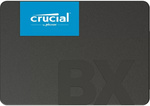Great price, as cheapest, next lower price is above $254.
Total Capacity:2TB
Warranty:Limited 3-year
Series:BX500
Product Line:Client SSD
Interface:SATA 6.0Gb/s
Form Factor:2.5-inch internal SSD
Read/Write speed:540 MB/s Read, 500 MB/s Write
Device Type:Internal Solid State Drive
Unit Height:7.0mm
Form Factor SSD:2.5-inch (7mm)
Package Content:Crucial BX500 3D NAND SATA 2.5-inch SSD, Acronis True Image for Crucial


DRAMLess TLC.
Good for bulk secondary storage. Not good for OS or sole storage, you want TLC with DRAM for that (MLC or SLC is better but you won't find any of that anywhere).
10c per GB is a great price for TLC.
I'd recommend this over ANYTHING QLC (aka anything that mentions 4 bits, as some companies like to call it 4 bit MLC to avoid the poor reputation of the term QLC, 4 bit MLC is technically true, but abuse of the term. SLC = Single, MLC = Multi but understood as two, TLC = Triple, QLC = Quad, each level addition is exponentially worse than its predecessors, so QLC isn't 4 times worse than SLC, but anywhere between 16-100 times worse as the tolerances aren't perfect slices)